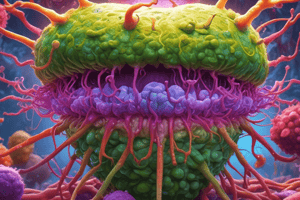Podcast
Questions and Answers
Which term refers to organisms that cause disease upon infection and are not normally associated with the host?
Which term refers to organisms that cause disease upon infection and are not normally associated with the host?
- Opportunistic pathogen
- Normal flora
- Pathogen transmission
- Primary pathogen (correct)
What was the first pathogen observed by scientists as described by Filippo Pacini in 1854?
What was the first pathogen observed by scientists as described by Filippo Pacini in 1854?
- Influenza virus
- Vibrio cholera (correct)
- HIV
- Yersinia pestis
Which type of pathogen causes disease under certain conditions and can be members of the normal flora?
Which type of pathogen causes disease under certain conditions and can be members of the normal flora?
- Pathogen transmission
- Normal flora
- Opportunistic pathogen (correct)
- Primary pathogen
Which of the following is an example of an opportunistic pathogen?
Which of the following is an example of an opportunistic pathogen?
What mode of transmission classifies pathogens based on food, air, water, blood, or vectors?
What mode of transmission classifies pathogens based on food, air, water, blood, or vectors?
Which organism is responsible for causing diseases like strep throat and tuberculosis?
Which organism is responsible for causing diseases like strep throat and tuberculosis?
What is the term used to describe the ability of a pathogen to adhere to a host?
What is the term used to describe the ability of a pathogen to adhere to a host?
Which factor plays a role in promoting disease formation by helping a pathogen to colonize a host?
Which factor plays a role in promoting disease formation by helping a pathogen to colonize a host?
What is the term that defines the degree of pathogenicity of a microorganism?
What is the term that defines the degree of pathogenicity of a microorganism?
Which ability of a pathogen is crucial for overcoming the host's defenses and leading to infection?
Which ability of a pathogen is crucial for overcoming the host's defenses and leading to infection?
What characteristic increases the likelihood of disease occurrence in a host due to a pathogen?
What characteristic increases the likelihood of disease occurrence in a host due to a pathogen?
Which defense mechanism of a pathogen contributes to its ability to persist and infect a host?
Which defense mechanism of a pathogen contributes to its ability to persist and infect a host?
How do wounds in barrier epithelia contribute to pathogen colonization of the host?
How do wounds in barrier epithelia contribute to pathogen colonization of the host?
Which of the following is NOT mentioned as a location where protective boundaries are less robust in the human body?
Which of the following is NOT mentioned as a location where protective boundaries are less robust in the human body?
In what way can a pathogen efficiently cross the skin to infect a host?
In what way can a pathogen efficiently cross the skin to infect a host?
Why is adherence an essential step in bacterial pathogenesis?
Why is adherence an essential step in bacterial pathogenesis?
What feature enables viruses spread by insect bites to cause diseases like yellow fever?
What feature enables viruses spread by insect bites to cause diseases like yellow fever?
Why do dedicated pathogens not need to wait for a well-timed wound to infect a host?
Why do dedicated pathogens not need to wait for a well-timed wound to infect a host?
Flashcards are hidden until you start studying




